Adam Czajka
Divisive Decisions: Improving Salience-Based Training for Generalization in Binary Classification Tasks
Jul 22, 2025Abstract:Existing saliency-guided training approaches improve model generalization by incorporating a loss term that compares the model's class activation map (CAM) for a sample's true-class ({\it i.e.}, correct-label class) against a human reference saliency map. However, prior work has ignored the false-class CAM(s), that is the model's saliency obtained for incorrect-label class. We hypothesize that in binary tasks the true and false CAMs should diverge on the important classification features identified by humans (and reflected in human saliency maps). We use this hypothesis to motivate three new saliency-guided training methods incorporating both true- and false-class model's CAM into the training strategy and a novel post-hoc tool for identifying important features. We evaluate all introduced methods on several diverse binary close-set and open-set classification tasks, including synthetic face detection, biometric presentation attack detection, and classification of anomalies in chest X-ray scans, and find that the proposed methods improve generalization capabilities of deep learning models over traditional (true-class CAM only) saliency-guided training approaches. We offer source codes and model weights\footnote{GitHub repository link removed to preserve anonymity} to support reproducible research.
Saliency-Guided Training for Fingerprint Presentation Attack Detection
May 04, 2025Abstract:Saliency-guided training, which directs model learning to important regions of images, has demonstrated generalization improvements across various biometric presentation attack detection (PAD) tasks. This paper presents its first application to fingerprint PAD. We conducted a 50-participant study to create a dataset of 800 human-annotated fingerprint perceptually-important maps, explored alongside algorithmically-generated "pseudosaliency," including minutiae-based, image quality-based, and autoencoder-based saliency maps. Evaluating on the 2021 Fingerprint Liveness Detection Competition testing set, we explore various configurations within five distinct training scenarios to assess the impact of saliency-guided training on accuracy and generalization. Our findings demonstrate the effectiveness of saliency-guided training for fingerprint PAD in both limited and large data contexts, and we present a configuration capable of earning the first place on the LivDet-2021 benchmark. Our results highlight saliency-guided training's promise for increased model generalization capabilities, its effectiveness when data is limited, and its potential to scale to larger datasets in fingerprint PAD. All collected saliency data and trained models are released with the paper to support reproducible research.
Almost Right: Making First-layer Kernels Nearly Orthogonal Improves Model Generalization
Apr 23, 2025Abstract:An ongoing research challenge within several domains in computer vision is how to increase model generalization capabilities. Several attempts to improve model generalization performance are heavily inspired by human perceptual intelligence, which is remarkable in both its performance and efficiency to generalize to unknown samples. Many of these methods attempt to force portions of the network to be orthogonal, following some observation within neuroscience related to early vision processes. In this paper, we propose a loss component that regularizes the filtering kernels in the first convolutional layer of a network to make them nearly orthogonal. Deviating from previous works, we give the network flexibility in which pairs of kernels it makes orthogonal, allowing the network to navigate to a better solution space, imposing harsh penalties. Without architectural modifications, we report substantial gains in generalization performance using the proposed loss against previous works (including orthogonalization- and saliency-based regularization methods) across three different architectures (ResNet-50, DenseNet-121, ViT-b-16) and two difficult open-set recognition tasks: presentation attack detection in iris biometrics, and anomaly detection in chest X-ray images.
Salient Information Preserving Adversarial Training Improves Clean and Robust Accuracy
Jan 15, 2025Abstract:In this work we introduce Salient Information Preserving Adversarial Training (SIP-AT), an intuitive method for relieving the robustness-accuracy trade-off incurred by traditional adversarial training. SIP-AT uses salient image regions to guide the adversarial training process in such a way that fragile features deemed meaningful by an annotator remain unperturbed during training, allowing models to learn highly predictive non-robust features without sacrificing overall robustness. This technique is compatible with both human-based and automatically generated salience estimates, allowing SIP-AT to be used as a part of human-driven model development without forcing SIP-AT to be reliant upon additional human data. We perform experiments across multiple datasets and architectures and demonstrate that SIP-AT is able to boost the clean accuracy of models while maintaining a high degree of robustness against attacks at multiple epsilon levels. We complement our central experiments with an observational study measuring the rate at which human subjects successfully identify perturbed images. This study helps build a more intuitive understanding of adversarial attack strength and demonstrates the heightened importance of low-epsilon robustness. Our results demonstrate the efficacy of SIP-AT and provide valuable insight into the risks posed by adversarial samples of various strengths.
Iris Recognition for Infants
Jan 02, 2025



Abstract:Non-invasive, efficient, physical token-less, accurate and stable identification methods for newborns may prevent baby swapping at birth, limit baby abductions and improve post-natal health monitoring across geographies, within the context of both the formal (i.e., hospitals) and informal (i.e., humanitarian and fragile settings) health sectors. This paper explores the feasibility of application iris recognition to build biometric identifiers for 4-6 week old infants. We (a) collected near infrared (NIR) iris images from 17 infants using a specially-designed NIR iris sensor; (b) evaluated six iris recognition methods to assess readiness of the state-of-the-art iris recognition to be applied to newborns and infants; (c) proposed a new segmentation model that correctly detects iris texture within infants iris images, and coupled it with several iris texture encoding approaches to offer, to the first of our knowledge, a fully-operational infant iris recognition system; and, (d) trained a StyleGAN-based model to synthesize iris images mimicking samples acquired from infants to deliver to the research community privacy-safe infant iris images. The proposed system, incorporating the specially-designed iris sensor and segmenter, and applied to the collected infant iris samples, achieved Equal Error Rate (EER) of 3\% and Area Under ROC Curve (AUC) of 99\%, compared to EER$\geq$20\% and AUC$\leq$88\% obtained for state of the art adult iris recognition systems. This suggests that it may be feasible to design methods that succesfully extract biometric features from infant irises.
Training Better Deep Learning Models Using Human Saliency
Oct 21, 2024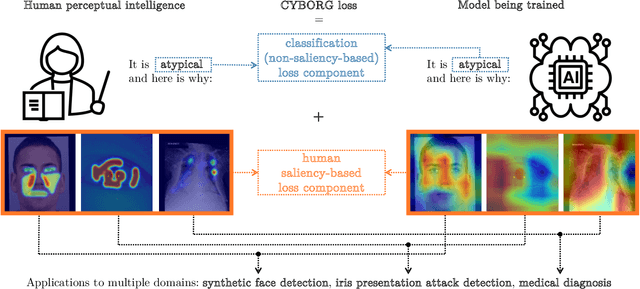
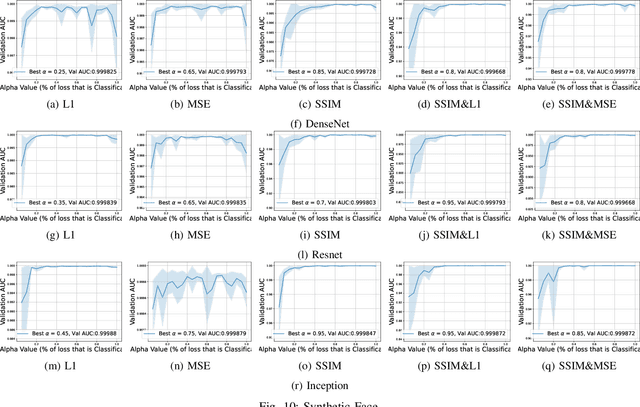
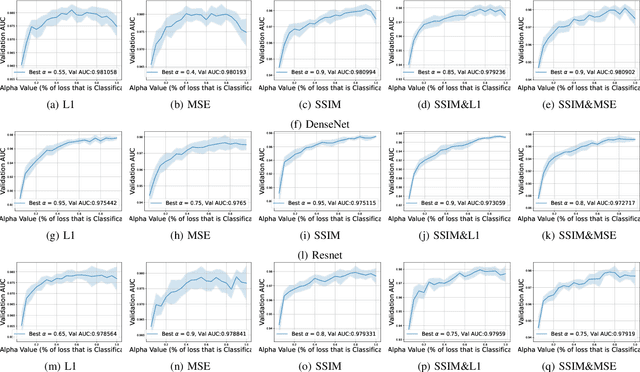
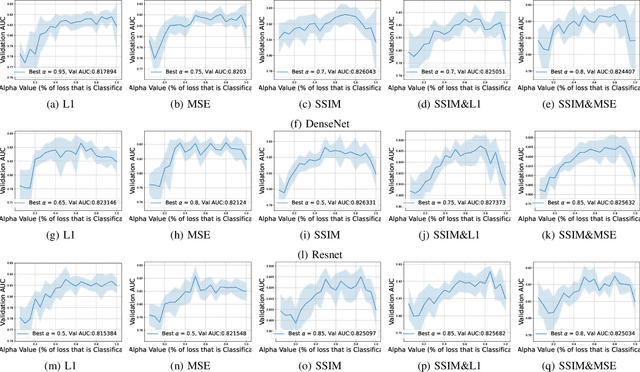
Abstract:This work explores how human judgement about salient regions of an image can be introduced into deep convolutional neural network (DCNN) training. Traditionally, training of DCNNs is purely data-driven. This often results in learning features of the data that are only coincidentally correlated with class labels. Human saliency can guide network training using our proposed new component of the loss function that ConveYs Brain Oversight to Raise Generalization (CYBORG) and penalizes the model for using non-salient regions. This mechanism produces DCNNs achieving higher accuracy and generalization compared to using the same training data without human salience. Experimental results demonstrate that CYBORG applies across multiple network architectures and problem domains (detection of synthetic faces, iris presentation attacks and anomalies in chest X-rays), while requiring significantly less data than training without human saliency guidance. Visualizations show that CYBORG-trained models' saliency is more consistent across independent training runs than traditionally-trained models, and also in better agreement with humans. To lower the cost of collecting human annotations, we also explore using deep learning to provide automated annotations. CYBORG training of CNNs addresses important issues such as reducing the appetite for large training sets, increasing interpretability, and reducing fragility by generalizing better to new types of data.
Privacy-Safe Iris Presentation Attack Detection
Aug 05, 2024



Abstract:This paper proposes a framework for a privacy-safe iris presentation attack detection (PAD) method, designed solely with synthetically-generated, identity-leakage-free iris images. Once trained, the method is evaluated in a classical way using state-of-the-art iris PAD benchmarks. We designed two generative models for the synthesis of ISO/IEC 19794-6-compliant iris images. The first model synthesizes bona fide-looking samples. To avoid ``identity leakage,'' the generated samples that accidentally matched those used in the model's training were excluded. The second model synthesizes images of irises with textured contact lenses and is conditioned by a given contact lens brand to have better control over textured contact lens appearance when forming the training set. Our experiments demonstrate that models trained solely on synthetic data achieve a lower but still reasonable performance when compared to solutions trained with iris images collected from human subjects. This is the first-of-its-kind attempt to use solely synthetic data to train a fully-functional iris PAD solution, and despite the performance gap between regular and the proposed methods, this study demonstrates that with the increasing fidelity of generative models, creating such privacy-safe iris PAD methods may be possible. The source codes and generative models trained for this work are offered along with the paper.
Grains of Saliency: Optimizing Saliency-based Training of Biometric Attack Detection Models
May 01, 2024Abstract:Incorporating human-perceptual intelligence into model training has shown to increase the generalization capability of models in several difficult biometric tasks, such as presentation attack detection (PAD) and detection of synthetic samples. After the initial collection phase, human visual saliency (e.g., eye-tracking data, or handwritten annotations) can be integrated into model training through attention mechanisms, augmented training samples, or through human perception-related components of loss functions. Despite their successes, a vital, but seemingly neglected, aspect of any saliency-based training is the level of salience granularity (e.g., bounding boxes, single saliency maps, or saliency aggregated from multiple subjects) necessary to find a balance between reaping the full benefits of human saliency and the cost of its collection. In this paper, we explore several different levels of salience granularity and demonstrate that increased generalization capabilities of PAD and synthetic face detection can be achieved by using simple yet effective saliency post-processing techniques across several different CNNs.
SiNC+: Adaptive Camera-Based Vitals with Unsupervised Learning of Periodic Signals
Apr 20, 2024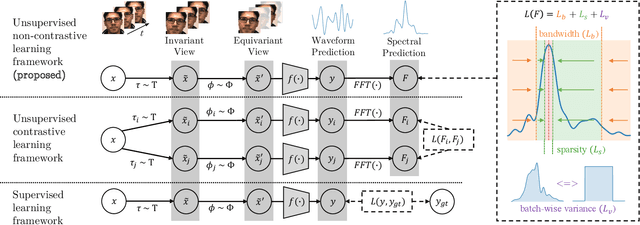
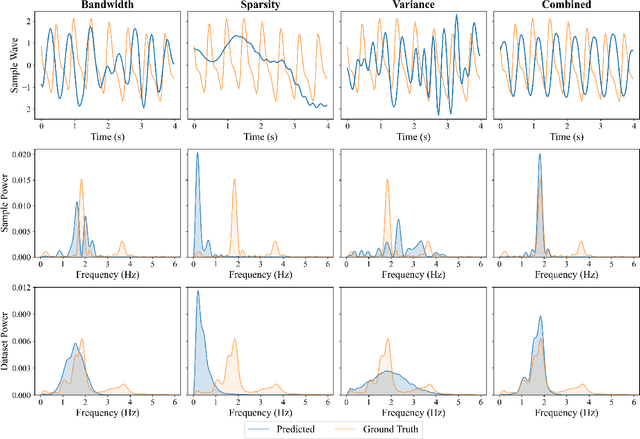
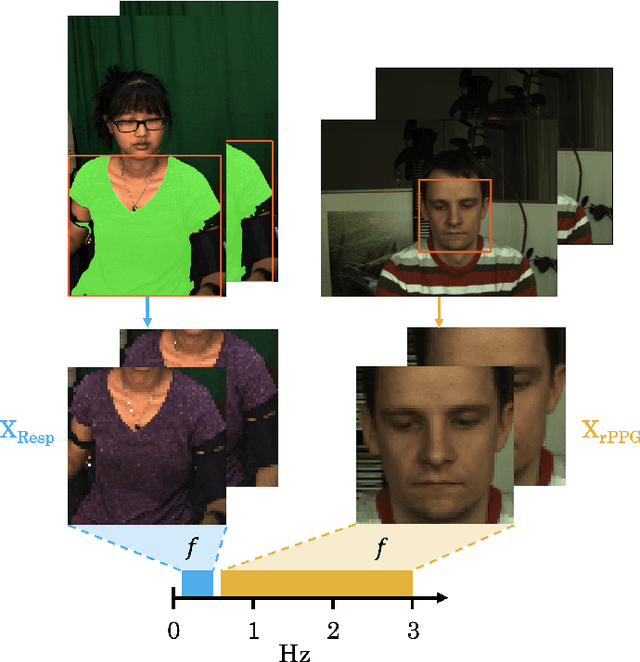
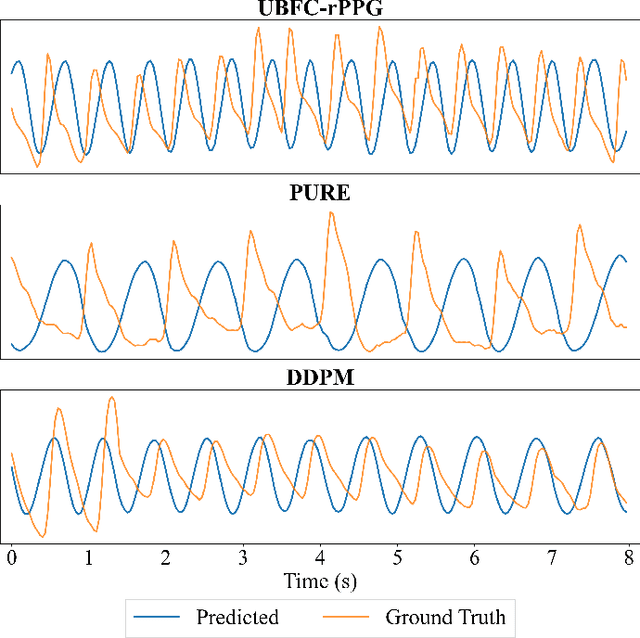
Abstract:Subtle periodic signals, such as blood volume pulse and respiration, can be extracted from RGB video, enabling noncontact health monitoring at low cost. Advancements in remote pulse estimation -- or remote photoplethysmography (rPPG) -- are currently driven by deep learning solutions. However, modern approaches are trained and evaluated on benchmark datasets with ground truth from contact-PPG sensors. We present the first non-contrastive unsupervised learning framework for signal regression to mitigate the need for labelled video data. With minimal assumptions of periodicity and finite bandwidth, our approach discovers the blood volume pulse directly from unlabelled videos. We find that encouraging sparse power spectra within normal physiological bandlimits and variance over batches of power spectra is sufficient for learning visual features of periodic signals. We perform the first experiments utilizing unlabelled video data not specifically created for rPPG to train robust pulse rate estimators. Given the limited inductive biases, we successfully applied the same approach to camera-based respiration by changing the bandlimits of the target signal. This shows that the approach is general enough for unsupervised learning of bandlimited quasi-periodic signals from different domains. Furthermore, we show that the framework is effective for finetuning models on unlabelled video from a single subject, allowing for personalized and adaptive signal regressors.
Forensic Iris Image-Based Post-Mortem Interval Estimation
Apr 15, 2024Abstract:Post-mortem iris recognition is an emerging application of iris-based human identification in a forensic setup. One factor that may be useful in conditioning iris recognition methods is the tissue decomposition level, which is correlated with the post-mortem interval (PMI), i.g., the number of hours that have elapsed since death. PMI, however, is not always available, and its precise estimation remains one of the core challenges in forensic examination. This paper presents the first known to us method of PMI estimation directly from forensic iris images. To assess the feasibility of the iris-based PMI estimation, convolutional neural networks-based models (VGG19, DenseNet121, ResNet152, and Inception_v3) were trained to predict the PMI from (a) near-infrared (NIR), (b) visible (RGB), and (c) multispectral forensic iris images. Models were evaluated following a 10-fold cross-validation in (S1) sample-disjoint, (S2) subject-disjoint, and (S3) cross-dataset scenarios. We found that using the multispectral data offers a spectacularly low mean absolute error (MAE) of approximately 3.5 hours in scenario (S1), a bit worse MAE of approximately 17.5 hours in scenario (S2), and an MAE of approximately 69.0 hours of in the scenario (S3). This suggests that if the environmental conditions are favorable (e.g., bodies are kept in low temperatures), forensic iris images provide features that are indicative of the PMI and can be automatically estimated. The source codes and model weights are made available with the paper.
 Add to Chrome
Add to Chrome Add to Firefox
Add to Firefox Add to Edge
Add to Edge